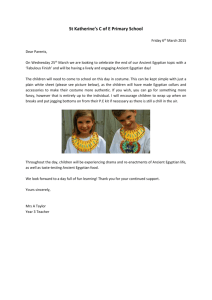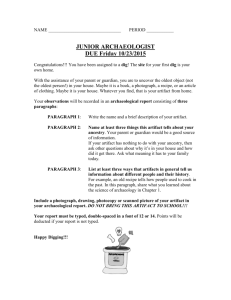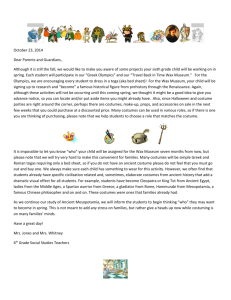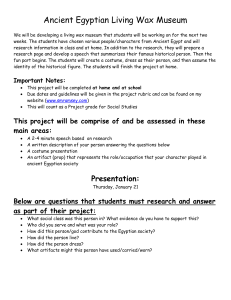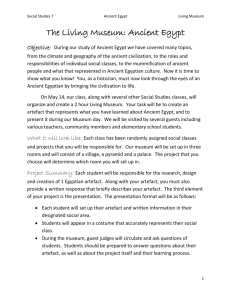read this
advertisement
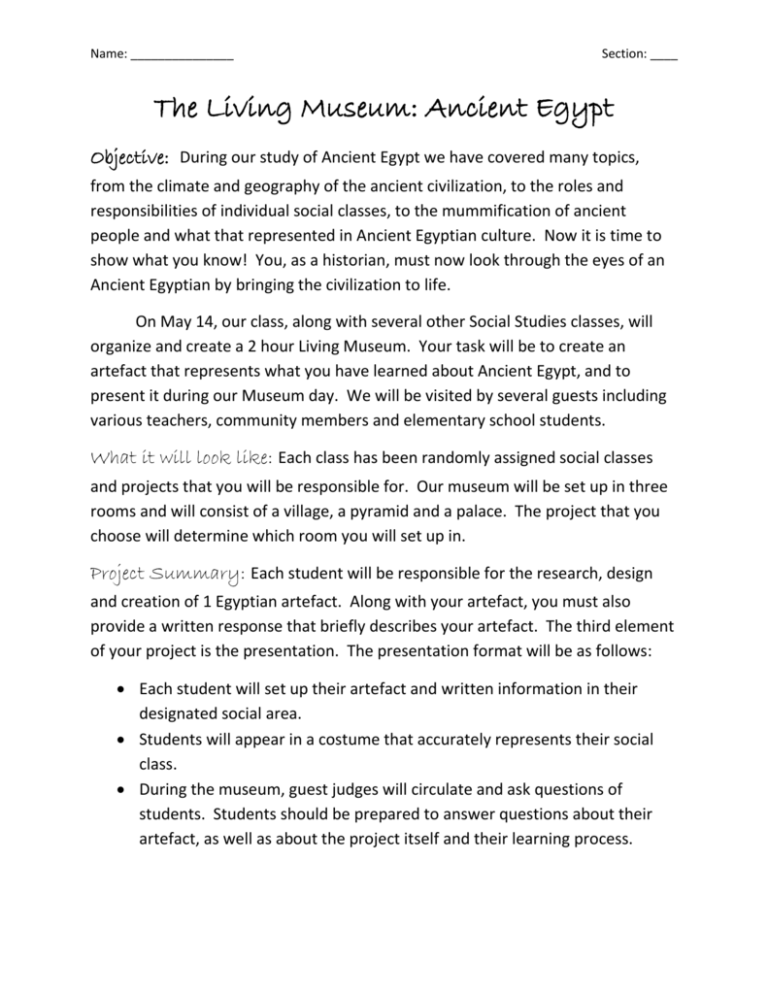
Name: _______________ Section: ____ The Living Museum: Ancient Egypt Objective: During our study of Ancient Egypt we have covered many topics, from the climate and geography of the ancient civilization, to the roles and responsibilities of individual social classes, to the mummification of ancient people and what that represented in Ancient Egyptian culture. Now it is time to show what you know! You, as a historian, must now look through the eyes of an Ancient Egyptian by bringing the civilization to life. On May 14, our class, along with several other Social Studies classes, will organize and create a 2 hour Living Museum. Your task will be to create an artefact that represents what you have learned about Ancient Egypt, and to present it during our Museum day. We will be visited by several guests including various teachers, community members and elementary school students. What it will look like: Each class has been randomly assigned social classes and projects that you will be responsible for. Our museum will be set up in three rooms and will consist of a village, a pyramid and a palace. The project that you choose will determine which room you will set up in. Project Summary: Each student will be responsible for the research, design and creation of 1 Egyptian artefact. Along with your artefact, you must also provide a written response that briefly describes your artefact. The third element of your project is the presentation. The presentation format will be as follows: Each student will set up their artefact and written information in their designated social area. Students will appear in a costume that accurately represents their social class. During the museum, guest judges will circulate and ask questions of students. Students should be prepared to answer questions about their artefact, as well as about the project itself and their learning process. TASK 1: (PARAGRAPH) Write a research paragraph that includes detailed answer to several (given) questions. During your museum presentation you will use this as a reference when asked questions. Your written response should meet the following criteria: Assessment Criteria Paragraphs will be marked for accurate and detailed research that addresses all the questions listed. Paragraphs will be marked for grammar, polished editing, presentation and proper paragraph format. Research should be back up by several (2-3) credible sources that are listed in full below the paragraph. Paragraph Accurate & Detailed Research Fully Meeting Formatting & Editing Research Meeting Paragraph addresses all questions; facts are accurate, but lack some detail. Paragraph includes all parts, but has minor errors in spelling, grammar or writing. Paragraph lists at least 1 credible source Minimally Meeting TASK 2: (ARTIFACT) Create and Ancient Egyptian artifact. During your museum presentation you will display your creation and answer questions about it. Your artifact should meet the following criteria: Assessment Criteria Artifact accurately represents an Ancient Egyptian object Resources are creatively and effectively used Artefact Content Resources Fully Meeting Meeting Artifact is an accurate representation of Ancient Egyptian life and culture; shows thoughtfulness and creativity. Materials, supplies and resources are used to clearly represent the artifact. Minimally Meeting 2 TASK 3: (COSTUME) During the Living Museum, wear a costume that would be worn by someone in your social role. During your museum presentation you should be able to answer questions about it. Your costume should meet the following criteria: Assessment Criteria Costume accurately represents the dress of an Ancient Egyptian in your social role. Artefact Costume Fully Meeting Meeting Costume is an accurate representation of the dress of an Ancient Egyptian of the student’s chosen social status. Minimally Meeting TASK 4: (PRESENTATION) The final portion of your mark will come from your presentation itself. During the Living Museum guest judges will be circulating, stopping to ask questions and to take a look at your wonderful museum pieces. Guest judges will assign a mark out of 3 to each of the following criteria: Assessment Criteria (Used by Guest Judges) Student demonstrates knowledge of their artifact, costume and social role. Student used voice, posture and eye contact to create an inviting presentation. Presentation Knowledge Inviting Presentation Fully Meeting Meeting Student can answer most questions about their artifact, costume and social role. Minimally Meeting Student makes a clear effort to have eye contact, good posture, and a projecting voice, but sometimes struggles to do so effectively. 3 TASK 1: PARAGRAPH PLANNING PAGE GOAL: Write a research paragraph that includes detailed answer to each of the questions below. During your museum presentation you will use this as a reference when asked questions Step 1: Answer each of the following research questions in point form. Remember, for each new source you use, record it below. 1. What is your artifact? 2. What does your artifact look like? 3. What was it used for? 4. How was it used? 5. Who used it? 6. What does it tell us about Ancient Egyptian life? Step 2: Organize your research before you start typing your paragraph. Beside each question above write what part of the paragraph you want to include it in. (INTRO., IDEA 1, IDEA 2, IDEA 3, IDEA 4, CONCLUSION) Step 3: Type the rough draft of your paragraph. Step 4: Type up your sources below your paragraph Step 5: Get your paragraph edited by an adult. Step 6: Complete your final edit of your paragraph. Don't forget to polish it off, so it looks great. Sources: 1. 2. 3. 4 TASK 2 & 3: ARTIFACT & COSTUME PLANNING PAGE GOALS: Create and Ancient Egyptian artifact and a costume that would be worn by someone in your social role. Step 1: Write a list of all the materials and supplies you will need to make your artifact. Remember, besides the basics, you will need to get these materials yourself. Artifact Supplies Costume Materials Step 2: Set a clear timeline for yourself so that you can complete your artifact and costume on time. Day 1 (_________________) Day 4(_________________) Write paragraph Practice Presentation Day 2 (_________________) Day 5(_________________) Living Museum presentation Day 3(_________________) 5 Project Options (7.2) Option #6: Craftsmen (Sarcophagus) (Maximum Students: 15) Are you a crafty individual? Do you like to build things with your hands? Then why not build a sarcophagus? As a craftsman you get to enjoy some of the nice things of life without feeling the Pharaoh breathing down your neck. You enjoy everyday life in the village, and people come from miles around to check out the amazing things that you make. Do you have the skills to build a sarcophagus? Explore the amazing world of Egyptian coffins and see if you can outdo your fellow craftsmen to make the make sarcophagus ever. If working with your hand appeals to you, choose Option #6. Option #7: Scribes (Hieroglyphs)(Maximum Students: 15) Do you like to write? What if instead of using the alphabet you could draw pictures? Typically scribes spent their entire days copying out important texts and recording important legal documents. With hieroglyphs this is practically a job where you get to doodle all day. As a scribe you will take an important piece of writing of your choice and write it in hieroglyphs. Then, you can have all the fun you want making the final product look old and worn. Creativity is not limited here. Maybe instead of paper, you want to use clay. What were the pyramid walls made of, anyway? If you want to find out this and more, you should choose Option #7! Option #3: Slaves (Pyramid Building)(Maximum Students: 5) Typically when people think Egypt, they think PYRAMIDS. This project will allow you to design and create an authentic pyramid that would make a pharaoh proud. Build a 3-D model or draw a label a blueprint plan. Either way, project 3 will give you a hands-on, insider look at the mysteries of the Egyptian pyramids. If this is for you, choose Option #3.
